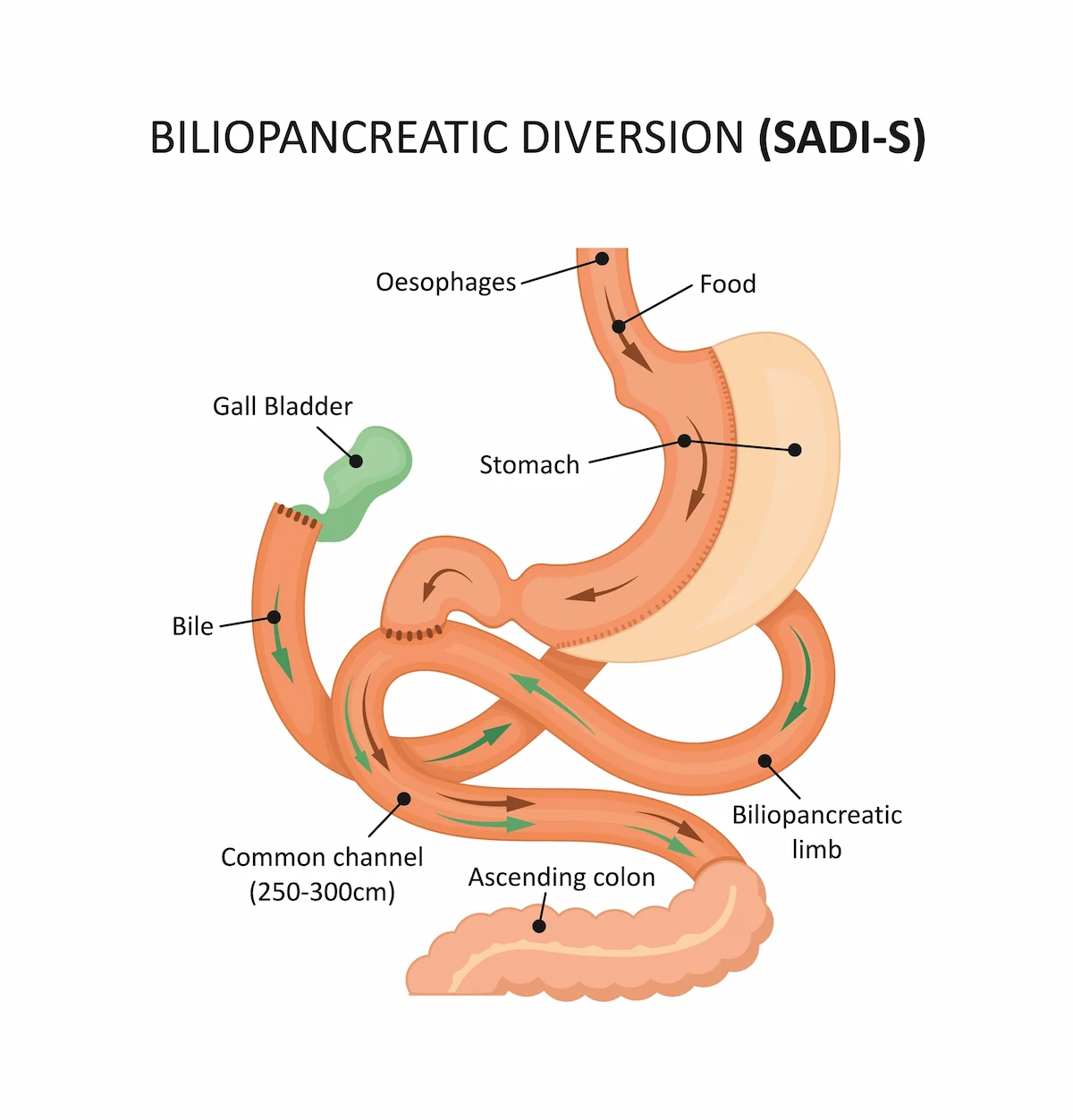Duodenal Switch (SADI)

Coming Soon!
The board-certified bariatric surgeons at Northwest Weight & Wellness Center (NWWC) are highly regarded for their compassionate and comprehensive approach to weight loss surgery. For patients seeking an effective obesity treatment, we offer duodenal switch surgery at our Everett, Washington bariatric practice. We have helped many patients from Seattle, the greater Pacific Northwest, and beyond, to live happier and healthier lives.
- What is Single Anastomosis Duodenal Switch (SADI) and How Does it Work?
- Am I a Good Candidate for Bariatric Surgery?
- Benefits of Duodenal Switch Surgery
- What to Expect From Duodenal Switch Surgery
- Preparing for Duodenal Switch Surgery
- Your Duodenal Switch Surgery
- Recovery After Duodenal Switch Surgery
- Duodenal Switch Compared to Other Weight Loss Procedures
- Frequently Asked Questions About Duodenal Switch Surgery
What is Single Anastomosis Duodenal Switch (SADI)?
Despite the fact that it results in significant weight loss, Duodenal switch surgery (DS) is less commonly known than gastric sleeve or gastric bypass, which may be in part because it is a more complex surgery. Additionally, the traditional approach to duodenal switch, also called biliopancreatic diversion with duodenal switch, sometimes resulted in unfavorable side effects. However, Single Anastomosis Duodenal Switch, sometimes called SADI-S or “Loop DS” is a safer, more modern approach to duodenal switch surgery that minimizes the risk of
Trusted Source
“SADI-S WITH RIGHT GASTRIC ARTERY LIGATION: TECHNICAL SYSTEMATIZATION AND EARLY RESULTS
Gebelli, Jordi Pujol et al
Go to Source
complications.
During duodenal switch surgery, a portion of the stomach is removed, similar to a sleeve gastrectomy procedure. Then, the surgeon divides the duodenum, which is part of the small intestine, and reroutes it to the lower intestine. The main difference between SADI and traditional DS surgery, is that the intestines are rerouted at a single connection spot instead of two connection spots.

How Does Duodenal Switch Work?
Single Anastomosis Duodenal Switch surgery promotes weight loss in three ways:
- Restriction: the size of the stomach is reduced to limit the amount of food you can eat
- Malabsorption: The digestive system is rerouted so that fewer calories are absorbed in the intestine
- Hormonal: the body’s production of ghrelin, the “hunger hormone” is reduced so you feel fewer food cravings

Am I a Good Candidate for Bariatric Surgery?
A bariatric procedure may be right for you if you have tried to lose weight through diet and exercise, but your efforts have been unsuccessful or you have not been able to maintain long-term weight loss. While, in general, bariatric surgery candidates have a body mass index (BMI) higher than 40 or a BMI of 35 or more along with obesity-related medical conditions, duodenal switch surgery is often reserved for patients with a BMI above 50. One thing that all candidates have in common is a willingness to commit to new habits and a healthier lifestyle. The experts at NWWC can explain your options and help determine the best weight loss procedure for you.
Benefits of Duodenal Switch Surgery
- Patients lose weight quickly and can lose up to 80% of excess body
Trusted Source Duodenal switch provides superior weight loss in the super-obese (BMI > or =50 kg/m2) compared with gastric bypass Prachand VN, Davee RT, Alverdy JC Go to Source weight
- The most effective bariatric surgery for treating type 2
Trusted Source The role of bariatric surgery to treat diabetes: current challenges and perspectives Koliaki C, Liatis S, le Roux CW, Kokkinos A Go to Source diabetes
- In addition to type 2 diabetes, duodenal switch can also improve health problems such as joint pain, sleep apnea, high cholesterol, and high blood pressure
- Patients may have fewer post-surgery food restrictions than with other procedures
What to Expect From Duodenal Switch Surgery
Preparing for Duodenal Switch Surgery
The first step is to schedule a consultation appointment with one of our bariatric surgeons. We will review your medical history, discuss your goals, and examine you in order to determine if you are a candidate. If duodenal switch surgery is right for you, we will give you detailed pre-surgical instructions.
Your Duodenal Switch Surgery
We perform most of our bariatric procedures at Sound Surgeons, which is our specialized and fully accredited surgical center. Our surgeons use laparoscopic techniques, so you will have smaller incisions and an easier recovery. Duodenal switch surgery is typically an outpatient procedure performed with general anesthesia.
Recovery After Duodenal Switch Surgery
We will schedule follow-up appointments to monitor your progress and healing after your duodenal switch procedure. You will need to take at least one full week off of work and you will need to refrain from strenuous activities for several weeks. We will advise you on lifestyle changes and you’ll receive support from our dietitian on your post-procedure diet. Since duodenal switch is a malabsorptive procedure, we may also recommend dietary supplementation to ensure you get the calcium, vitamins and nutrients you need.
Duodenal Switch Compared to Other Weight Loss Procedures
- reversible
- Improvement of conditions such as Type 2 diabetes
- Decreased hunger
- Long-term weight loss
- Improvement of conditions such as Type 2 diabetes
- Decreased hunger
- Long-term weight loss
- Improvement of conditions such as Type 2 diabetes
- Decreased hunger
- Long-term weight loss
- High rate of complications
- Lower rate of weight loss
- Requires ongoing maintenance
- Not reversible
- Not reversible
- Potential for malnutrition
- Not reversible
- Potential for malnutrition
Frequently Asked Questions About Duodenal Switch Surgery
Will insurance cover duodenal switch surgery?
Many insurance plans offer coverage for patients who are candidates for duodenal switch. Contact our insurance verification team to learn more.
What is the difference between gastric bypass and duodenal switch?
Both duodenal switch and gastric bypass, also known as roux-en-y gastric bypass, are effective weight loss surgeries. The primary difference is that in a gastric bypass procedure, the intestines are rerouted, leaving a small gastric pouch for food; in a duodenal switch procedure, a portion of the stomach is removed and the intestines are rerouted. A DS procedure is sometimes compared to having both a gastric sleeve and gastric bypass together.
What are the potential risks of duodenal switch surgery?
Any surgical procedure carries some risk of side effects or complications. You can minimize your risks by choosing an experienced, board-certified surgeon and following all post-surgery instructions. The most common risks of duodenal switch surgery include bleeding, infection or anesthesia risks during surgery. Many long-term risks, such as “dumping syndrome” are significantly reduced with the SADI approach.
Do you accept traveling patients?
Yes, we have helped many patients who travel to us from across the country, including Alaska, Montana, and Idaho, as well as from Canada. We offer our expertise in a patient-centered environment and we are happy to support traveling patients.
Contact Us
Are you ready to improve your health and quality of life? We can give you the tools you need to achieve long-term weight loss success. Contact us to schedule your consultation.
1 Gebelli, Jordi Pujol et al. “SADI-S WITH RIGHT GASTRIC ARTERY LIGATION: TECHNICAL SYSTEMATIZATION AND EARLY RESULTS.” Arquivos brasileiros de cirurgia digestiva : ABCD = Brazilian archives of digestive surgery vol. 29Suppl 1,Suppl 1 (2016): 85-90. doi:10.1590/0102-6720201600S10021
2 National Institutes of Health. Potential Candidates for Weight-loss Surgery. Available: https://www.niddk.nih.gov/health-information/weight-management/bariatric-surgery/potential-candidates Accessed April 25, 2022.
3 Koliaki C, Liatis S, le Roux CW, Kokkinos A. The role of bariatric surgery to treat diabetes: current challenges and perspectives. BMC Endocr Disord. 2017;17(1):50. Published 2017 Aug 10. doi:10.1186/s12902-017-0202-6










